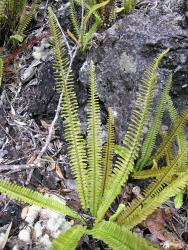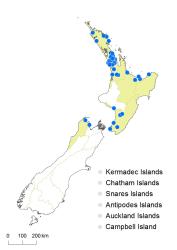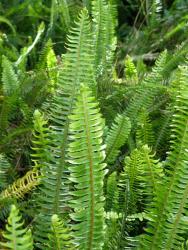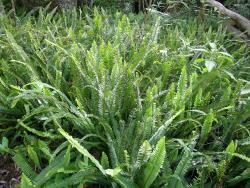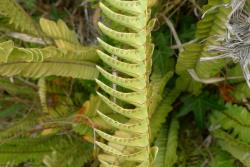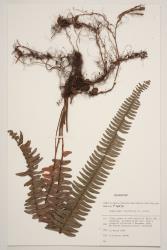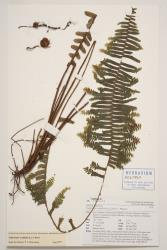- Taxon
- Weed
- ≡ Polypodium cordifolium L., Sp. Pl. 1089 (1753) nom. cons.
- ≡ Aspidium cordifolium (L.) Sw., J. Bot. (Schrader) 1800(2): 32 (1801)
- = Polypodium auriculatum L., Sp. Pl. 1088 (1753) nom. rej.
- ≡ Nephrolepis auriculata (L.) Trimen, J. Linn. Soc., Bot. 24: 152 (1887)
- = Aspidium tuberosum Bory ex Willd., Sp. Pl. 5(1), 234 (1810)
- ≡ Nephrodium tuberosum (Bory ex Willd.) Desv., Mém. Soc. Linn. Paris 6: 252 (1827)
- ≡ Nephrolepis tuberosa (Bory ex Willd.) C.Presl, Tent. Pterid. 79 (1836)
Terrestrial ferns. Rhizomes erect, densely scaly, producing long-creeping runners with adventitious buds and tubers. Rhizome scales spreading, narrowly ovate, tapering from a broad base to a filiform apex, 5.5–7.0 mm long, 0.9–1.7 mm wide, peltate, light brown, dull, margins irregularly lacerate at base with ciliate projections. Fronds 260–1130 mm long. Stipes 20–570 mm long, pale brown, brittle, densely scaly. Rachises pale brown, densely scaly; rachis scales spreading, narrowly ovate to linear, light brown, margins irregularly lacerate at base with ciliate projections. Laminae 1-pinnate, narrowly elliptic to linear, tapering to apex; fertile laminae 240–1020 mm long, 30–100 mm wide, yellow-green on both surfaces, herbaceous; lamina surfaces lacking scales or with very scattered hair-like scales, sometimes bearing multicellular hairs. Primary pinnae in 45–110 pairs, not or slightly overlapping; the longest near the middle, 15–53 mm long, 5–9 mm wide, narrowly ovate or oblong with a pointed basal acroscopic lobe, slightly falcate; basal pinnae much reduced; pinna apices obtuse or rounded, margins serrate to deeply lobed, bases short-stalked and unequally auricled. Sori round, close to margin; indusia lunulate, attached at broad base, 0.7–0.8 mm long. Mean spore size 28–33 μm long, 18–22 μm wide; perispores pale brown, tuberculate.
Nephrolepis cordifolia is a naturalised species that is very similar to the indigenous N. flexuosa. It is distinguished by the presence of tubers on its long-creeping runners, by its more abundantly scaly rhizomes and stipe bases, and by its generally longer and wider laminae (240–1020 mm long, 30–100 mm wide, cf. 170–620 mm long, 18–50 mm wide). The rhizome scales are also longer and wider (5.5–7 mm long, 0.9–1.7 mm wide, cf. 3–5 mm long, 0.2–0.5 mm wide), with lacerate rather than entire bases. Nephrolepis cordifolia is a diploid species (2n = 82) and has smaller spores than the tetraploid N. flexuosa (28–33 μm long, 18–22 μm wide, cf. 36–38.5 μm long, 23–25 μm wide). It is distinguished from both N. brownii and N. exaltata by its lunulate, rather than reniform, indusia.
Plants with pinnatisect apices to some of the primary pinnae are occasionally found and are referable to ‘Plumosa’ (Hoshizaki & Moran 2001). Plants of this cultivar from Orewa and the Waitākere Ranges, Auckland, were illustrated by Large & Farrington 2016, fig. 1b), and have also been collected from urban sites in Hamilton, Tauranga and Wellington. Large & Farrington noted the apparent absence of tubers in this cultivar, but tubers can be seen in at least some collections (see Fig. 12). Large & Farrington also noted that plants were often sterile with a high degree of spore irregularity and abortion, but whether this was due to unsuitable climatic conditions or an indication of hybrid origin was unclear.
North Island: Northland, Auckland, Volcanic Plateau, Gisborne, Southern North Island.
South Island: Western Nelson.
Altitudinal range: 0–240 m.
Nephrolepis cordifolia is widely naturalised in the northern North Island from Northland to the Bay of Plenty and Gisborne, and again in the southern North Island from Whanganui to Wellington. It is confined to coastal and lowland districts, reaching 240 m on Whale Island in the Bay of Plenty. There are records from Golden Bay and Tasman Bay in the South Island.
Occurs naturally in the Neotropics from Cuba to Venezuela, and in the Paleotropics from Madagascar to India, Sri Lanka, China, south-east Asia, Australia (Queensland, New South Wales), Vanuatu, New Caledonia, Samoa and Hawai‘i (Hovenkamp & Miyamoto 2005; de Lange et al. 2005). Naturalised in Central America and Mexico (Mickel & Smith 2004), parts of Africa (Roux 2009), south-east Australia (Bell 1998), Norfolk Island (de Lange et al. 2005) and the Cook Islands (Sykes 2016).
Nephrolepis cordifolia is now a serious environmental weed that occurs not only around current or former sites of human habitation, and on the sides of roads or railways, but also in urban forest remnants and coastal forest. It is common on scoria banks and rough lava, but also on rock walls, the sides of buildings, among boulders and under open pōhutukawa, mānuka, kānuka, Eucalyptus and pine, sometimes on thermally heated soil. Some occurrences possibly result from deliberate plantings undertaken in the mistaken belief that the species is indigenous.
Heath & Chinnock (1974). Earliest voucher: AK 289696, 1887, in cultivation; AK 251931, 1928.
2n = 82 (de Lange et al. 2004).
Plants of Nephrolepis have been widely cultivated in northern New Zealand since the late 19th century, although they were not recorded in the wild until much later, and it is entirely possible that both species and hybrids have occasionally escaped. Further work is needed to determine the status of plants with aborted spores.



